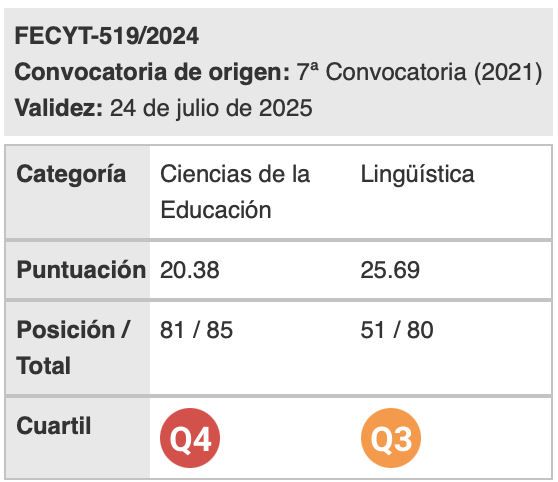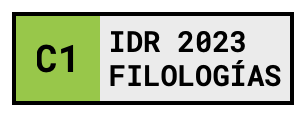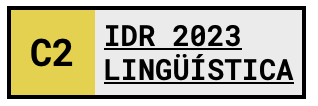Iberian-Romance borrowings into English in the fortified wine industry: Implications for wine educators
Palabras clave:
Comunicación en las industrias vitivinícolas, Palabras de préstamo de lenguas iberorrománicas, Modelos de conocimiento profesional, Terminología multilingüe, Discurso profesionalResumen
El inglés tiende a considerarse suficiente para la comunicación en numerosos campos. Esto incluye industrias cuyo progreso ha dependido de la comunicación en lenguas distintas del inglés, en las que este idioma ha sido útil en cuestiones comerciales. Un ejemplo notable es el microcampo de los vinos generosos, en el que las lenguas principales son el portugués (madeira y oporto) y el español (jerez), siendo el inglés históricamente importante, como demuestran los documentos ingleses. Dado que el corpus inglés muestra préstamos no asimilados de las lenguas ibero-románicas, y que prestigiosas escuelas de vino, como AWRI, Napa Valley Wine Academy, WSET, por nombrar algunas, ofrecen a sus estudiantes pocas oportunidades de aprender estas lenguas, parecía razonable proporcionar pruebas numéricas de la presencia de estos préstamos en la comunicación profesional en inglés para ver si los posibles problemas de comprensión entre los estudiantes, resultantes de un discurso profesional lleno de palabras y expresiones extranjeras, pueden ser significativos. El estudio (motivado por el corpus) de sistemas conceptuales en los ámbitos del madeira, el oporto y el jerez ha llevado a la creación de modelos detallados en inglés que contienen préstamos del portugués y el español en proporciones variables. Los modelos se han explorado para demostrar hasta qué punto el inglés puede considerarse suficiente para una comunicación (eficaz) en cada una de las áreas de la industria de los vinos fortificados y, por la misma razón, dependiente de préstamos de las lenguas primarias de la industria. Las cifras establecidas de palabras de préstamo en las descripciones de madeira, oporto y jerez han indicado el grado en que los estudiantes de enología pueden confiar en sus conocimientos de inglés para comunicarse en sus profesiones de destino, al tiempo que revelan sus necesidades potenciales de portugués y español. Estos resultados informan a las ciencias lingüísticas aplicadas sobre la escala de préstamos que cabría esperar en el discurso profesional de un importante sector de la industria vitivinícola a partir de las lenguas primarias del campo, con el español identificado como una fuente relativamente más productiva de préstamos no asimilados que el portugués. Los resultados ofrecen una perspectiva para que los responsables de la elaboración de programas educativos consideren la inclusión de clases de portugués y español en los planes de estudios profesionales preparados para estudiantes que cursan estudios de enología y campos afines y que han elegido la especialización de vinos generosos.
Descargas
Citas
Algeo, J. (1996). Spanish loanwords in English by 1900. In F. Rodríguez González (Ed.), Spanish Loanwords in the English Language. A Tendency towards a Hegemony Reversal (Topics in English Linguistics, Vol. 18,), 13–40. Berlin & New York: Mouton de Gruyter.
ANSI/NISO Z39.19 (2005). Guidelines for the Construction, Format, and Management of Monolingual Controlled Vocabularies. Bethesda, MD: NISO Press.
Antia, B.E. (2017). Multilingual Terminology and Cognition in Assessment. In R.H. Kaschula, P. Maseko & H.E. Wolff (Eds.), Multilingualism and Intercultural Communication: A South African Perspective, 92–111. Johannesburg: Wits University Press.
AWRI (The Australian Wine Research Institute) (2021). Advanced Viticulture Course. Adelaide, SA: The Australian Wine Research Institute. www.awri.com.au [24.02.2022].
Barkin, F. (1980). The role of loanword assimilation in gender assignment. Bilingual Review / La Revista Bilingüe, Vol. 7, No. 2 (May–August 1980), 105–¬¬112.
Carling, G., Cronhamn, S., Farren, R., Aliyev, E., Frid, J. (2019). The causality of borrowing: Lexical loans in Eurasian languages. PLoS ONE, 14 (10). https://doi.org/10.1371/journal.pone.0223588 [9.01.2023].
Cossart, N. ([1984] 2011). Madeira. The Island Vineyard. Revised 2nd edition. Sonoma, CA: The Rare Wine Co.
Dahlberg, I. (1978). A referent-oriented, analytical concept theory for INTERCONCEPT. International Classification, Vol. 5, No. 3, 142–51.
Dahlberg, I. (1992). Knowledge Organization and Terminology: Philosophical and Linguistic Bases. International Classification, Vol. 19, No. 2, 65–71.
Dahlberg, I. (2011). How to Improve ISKO's Standing: Ten Desiderata for Knowledge Organization. Knowledge Organization, Vol. 38, No. 1, 68–74.
Eberhard, D.M., Simons, G.F., Fennig, C.D. (Eds.) (2021). Ethnologue: Languages of the World. Twenty-fourth edition. Dallas, Texas: SIL International. www.ethnologue.com [2.02.2022].
Gajda, Stanisław (2020). Terminologia a współczesna rzeczywistość naukowa. Poradnik Językowy, Issue 2020, No. 5, 7–17. https://doi.org/10.33896/PorJ.2020.5.1 [20.01.2023].
Gilchrist, A. (Ed.) ([2009] 2018). Information Science in Transition. London: Facet Publishing.
Górnicz, M. (2005a). Łańcuch terminologiczny. In J. Lukszyn (Ed.), Słownik terminologii przedmiotowej, 65. Katedra Języków Specjalistycznych, Uniwersytet Warszawski.
Górnicz, M. (2005b). Status kognitywny terminu. In J. Lukszyn (Ed.), Słownik terminologii przedmiotowej, 109. Katedra Języków Specjalistycznych, Uniwersytet Warszawski.
GRI (The Getty Research Institute) (2017a). Art & Architecture Thesaurus®. Los Angeles, CA: The Getty Research Institute. http://www.getty.edu/research/tools/vocabularies/aat [6.03.2022].
GRI (The Getty Research Institute) (2017b). Getty Thesaurus of Geographic Names®. Los Angeles, CA: The Getty Research Institute. http://www.getty.edu/research/tools/vocabularies/tgn [7.03.2022].
Grucza, F. ([1991] 2017). Terminologia. Jej przedmiot, status i znaczenie. In S. Grucza et al. (Eds.), Franciszek Grucza: Dzieła zebrane, 303–332. Warszawa: Wydawnictwo Naukowe Instytutu Komunikacji Specjalistycznej i Interkulturowej, Uniwersytet Warszawski.
Grucza, F. (2017). Lingwistyka stosowana. Historia – zadania – osiągnięcia. Warszawa: Wydawnictwo Naukowe Instytutu Komunikacji Specjalistycznej i Interkulturowej, Uniwersytet Warszawski.
Grucza, S. (2013). Lingwistyka języków specjalistycznych. Warszawa: Wydawnictwo Naukowe Instytutu Kulturologii i Lingwistyki Antropocentrycznej, Uniwersytet Warszawski.
Grucza, S. (2019). Terminologia (antropocentryczna) – jej przedmiot badań i zadania poznawcze. Applied Linguistics Papers, Vol. 26 No. 3, 1–13.
Halliday, J. & Johnson, H. ([1992] 2013). The Art and Science of Wine. Buffalo, NY: Firefly Books.
Hjørland, B. (2002). Principia Informatica. Foundational Theory of Information and Principles of Information Services. In H. Bruce, R. Fidel, P. Ingwersen, P. Vakkari (Eds.), Emerging Frameworks and Methods. Proceedings of the Fourth International Conference on Conceptions of Library and Information Science (CoLIS4), 109–121. Greenwood Village, CO: Libraries Unlimited.
Hjørland, B. (2009). Concept theory. Journal of the American Society for Information Science and Technology, Vol. 60, Issue 8. August 2009, 1519-1536. https://doi-1org-10000c85i2627.han.buw.uw.edu.pl/10.1002/asi.21082 [12.01.2023].
Hjørland, B. (2011). The importance of theory of knowledge: Indexing and information retrieval as an example. Journal of the American Society for Information Science and Technology, 62 (1), 72-77.
Hjørland, B. (2015). Theories are knowledge organizing systems (KOS). Knowledge Organization 42, No. 2, 113–128.
ISO 25964 (2013). The international standard for thesauri and interoperability with other vocabularies. Geneva: International Organization for Standardization.
Kamadjeu, R. (2019). English: the lingua franca of scientific research. The Lancet, Global Health, Volume 7, Issue 9 (September 2019), e1174.
Lacasta, J., Falquet, G., Zarazaga-Soria, F.J., Nogueras-Iso, J. (2016). An automatic method for reporting the quality of thesauri. Data & Knowledge Engineering, Volume 104, July 2016, 1–14.
Lakoff, G. (1987). Women, Fire, and Dangerous Things. What Categories Reveal about the Mind. Chicago & London: The University of Chicago Press.
Leski, K. (1978). Zasady budowy tezaurusów. Warszawa: OIN PAN.
Losee, R.M. (2007). Decisions in thesaurus construction and use. Information Processing and Management, 43 (2007), 958–968.
Lukszyn, J. (Ed.) (1998). Tezaurus terminologii translatorycznej. Wydawnictwo Naukowe PWN.
Lukszyn, J. (Ed.) (2005). Słownik terminologii przedmiotowej. Katedra Języków Specjalistycznych, Uniwersytet Warszawski.
Lukszyn, J. & Zmarzer, W. (2001). Teoretyczne podstawy terminologii. Warszawa: Katedra Języków Specjalistycznych Uniwersytetu Warszawskiego.
Łukasik, M. (2017). Polska szkoła terminograficzna. In S. Grucza & M. Małachowicz (Eds.), Polskie i europejskie nurty terminologiczne, 26–69. Warszawa: Wydawnictwo Naukowe Instytutu Komunikacji Specjalistycznej i Interkulturowej, Uniwersytet Warszawski.
Małachowicz, M. (2017). Polskie badania terminologiczne. In S. Grucza & M. Małachowicz (Eds.), Polskie i europejskie nurty terminologiczne, 8–25. Warszawa: Wydawnictwo Naukowe Instytutu Komunikacji Specjalistycznej i Interkulturowej, Uniwersytet Warszawski.
Mammen, J. (1994). En realistisk begrebsteori: Om forholdet mellem virksomhedsteorien og den økologiske kognitive psykologi. In Jens Mammen & Mariane Hedegaard (Eds.), Virksomhedsteori i udvikling, 43–58. Århus: Psychological Institute, University of Aarhus.
Mammen, J. (2008). What is a concept? Journal of Anthropological Psychology, 19, 25–27.
Masterman, M., Needham, R., Spärck-Jones, K. (1959). The Analogy between Mechanical Translation and Library Retrieval. Proceedings of the International Conference on Scientific Information, November 1958, Vol. 2, 917–936. Washington, D.C.: National Academy of Sciences.
Mayson, R. ([1999] 2018). Port and the Douro. 4th edition. Oxford: Infinite Ideas.
Mazur, M. (1961). Terminologia techniczna. Warszawa: Wydawnictwa Naukowo-Techniczne.
Medelyan, O., Milne, D., Legg, C., Witten, I.H. (2009). Mining meaning from Wikipedia. Journal of Human–Computer Studies, Vol. 67 (2009), 716–754.
Milošević, I. (2014). The Role of Cognitive Mechanisms and Semantic Motivation in Business English Idioms Acquisition: An experimental study. Journal of Foreign Language Teaching and Applied Linguistics, Fall 2014.
Myers-Scotton, C. (2006). Multiple Voices: an Introduction to Bilingualism. Malden, MA: Blackwell Publishing.
Nagórka, P. (2012). Analiza semantyczna a struktura jednostki informacyjnej. In W. Zmarzer (Ed.), Struktura jednostek informacyjnych, 23–50. Warszawa: IR, WLS, Uniwersytet Warszawski.
Nagórka, P. (2013). Thesaurus of Oenology. Warszawa: Piotr Nagórka / Linguistic Modelling.
Nagórka, P. & Pawłowski, G. (2018). Lingwistyka a terminologia – konflikt czy symbioza? Nowe perspektywy poznawcze dotyczące metodologii obu dyscyplin. In M. Aleksandrzak (Ed.), Języki specjalistyczne w lingwistyce stosowanej: między teorią i praktyką, 11-32. Poznań: Wydawnictwo Naukowe UAM.
Nagórka, P. (2021). Madeira, Port, Sherry: The Equinox Companion to Fortified Wines. Sheffield, UK & Bristol, CT: Equinox Publishing.
Nickerson, C. (2005). English as a lingua franca in international business contexts. English for Specific Purposes, Volume 24, Issue 4 (2005), 367–380.
Nowicki, W. (1979). Metoda pracy nad terminologią wybranej dziedziny. Warszawa: Wydawnictwo Czasopism i Książek Technicznych SIGMA.
Nowicki, W. (1986). Podstawy terminologii. Wrocław: Ossolineum.
Pavel, S. & Nolet, D. (2001). Handbook of Terminology. Adapted into English by Christine Leonhardt. Ottawa: Translation Bureau, Public Works and Government Services Canada.
Pawłowski, G. (2017). Fachlexeme in Konstruktion. Linguistischer Beitrag zur Erkenntnisarbeit. Frankfurt am Main: Peter Lang.
Pawłowski, G. (2021). Metafizyka poznania lingwistycznego. Warszawa: Wydawnictwa Uniwersytetu Warszawskiego.
Poplack, S. (2018). Borrowing: Loanwords in the Speech Community and in the Grammar. New York: Oxford University Press.
Porter, J.H. (2019). Evaluating a thesaurus for discovery of ecological data. Ecological Informatics, Volume 51, May 2019, 151–156.
Rey, A. (1995). Essays on terminology. Translated and edited by J.C. Sager. Amsterdam & Philadelphia: John Benjamins Publishing Company.
Roberts, N. (1984). Historical Studies in Documentation: The Pre-History of Information Retrieval Thesaurus. Journal of Documentation, December 1984, Vol. 40, No. 4, 271–285.
Rodríguez González, F. (1996). Introduction. In F. Rodríguez González (Ed.), Spanish Loanwords in the English Language. A Tendency towards a Hegemony Reversal (Topics in English Linguistics, Vol. 18), 1–12. Berlin & New York: Mouton de Gruyter.
Sibille-de Grimoüard, C. (2014). The Thesaurus for French Local Archives and the Semantic Web. Procedia – Social and Behavioral Sciences, 147 (2014), 206–212.
Sinclair, J. (1991). Corpus, Concordance, Collocation. Oxford, UK: Oxford University Press.
Szabo, J. (2016). Volcanic Wines: Salt, Grit and Power. London: Jacqui Small.
Temmerman, R. (1997). Questioning the Univocity Ideal. The Difference Between Socio-Cognitive Terminology and Traditional Terminology. Hermes, Journal of Linguistics, No. 18, 51–90. https://tidsskrift.dk/her/article/view/25412/22333 [12.02.2023].
Tognini-Bonelli, E. (2001). Corpus Linguistics at Work. Amsterdam & Philadelphia: John Benjamins Publishing Company.
Trowbridge, B. (2016). History’s Unparalleled Alliance: the Anglo-Portuguese Treaty of Windsor, 9th May 1386. History of government, 9 May 2016. https://history.blog.gov.uk [21.02.2022].
Vizetelly, H. (1876). Facts about sherry. London: Ward, Lock and Tyler.
Vizetelly, H. (1880). Facts about Port and Madeira: With Notices of the Wines Vintaged Around Lisbon, and the Wines of Tenerife. London: Ward, Lock and Co.
USDA (United States Department of Agriculture) (2022). National Agricultural Library Thesaurus (20th edition). Washington, DC: United States Department of Agriculture. agclass.nal.usda.gov [27.02.2022].
WSET (Wine & Spirit Education Trust) (2017). WSET® Level 3 Award in Wines. Specification. London: Wine & Spirit Education Trust. www.wsetglobal.com [17.02.2022].
WSET (Wine & Spirit Education Trust) (2019). WSET® Level 2 Award in Wines. Specification. London: Wine & Spirit Education Trust. www.wsetglobal.com [17.02.2022].
WSET (Wine & Spirit Education Trust) (2020). WSET® Level 4 Diploma in Wines. Specification. London: Wine & Spirit Education Trust. www.wsetglobal.com [24.02.2022)].
WSET (Wine & Spirit Education Trust) (2021). WSET® Level 1 Award in Wines. Specification. London: Wine & Spirit Education Trust. www.wsetglobal.com [24.02.2022].
WSET (Wine & Spirit Education Trust) (2022). How to say it. London: Wine & Spirit Education Trust. www.wsetglobal.com [24.02.2022].
WSG (Wine Scholar Guild) (2021). Certified Sherry Wine Specialist (CSWS). Washington, DC: Wine Scholar Guild. www.winescholarguild.org [26.12.2021)].
WSG (Wine Scholar Guild) (2022). Path for SWE Students. Washington, DC: Wine Scholar Guild. www.winescholarguild.org [26.12.2022].
Zeng, Marcia Lei (2008). Knowledge Organization Systems. Knowledge Organization Vol. 35, Nos. 2-3, 160–82.
Zeng, Marcia Lei (2019). Interoperability. Knowledge Organization, Vol. 46, No. 2, 122–46. www.isko.org/cyclo/interoperability [11.01.2023].
Descargas
Publicado
Cómo citar
Número
Sección
Licencia
Aquellos autores/as que tengan publicaciones con esta revista, aceptan los términos siguientes:
- Los autores/as conservarán sus derechos de autor y garantizarán a la revista el derecho de primera publicación de su obra, el cuál estará simultáneamente sujeto a la Licencia de reconocimiento de Creative Commons que permite a terceros compartir la obra siempre que se indique su autor y su primera publicación esta revista.
- Los autores/as podrán adoptar otros acuerdos de licencia no exclusiva de distribución de la versión de la obra publicada (p. ej.: depositarla en un archivo telemático institucional o publicarla en un volumen monográfico) siempre que se indique la publicación inicial en esta revista.
- Se permite y recomienda a los autores/as difundir su obra a través de Internet (p. ej.: en archivos telemáticos institucionales o en su página web) antes y durante el proceso de envío, lo cual puede producir intercambios interesantes y aumentar las citas de la obra publicada. (Véase El efecto del acceso abierto).

Revista de Lenguas para fines específicos is licensed under a Creative Commons Reconocimiento-NoComercial-SinObraDerivada 4.0 Internacional License.























